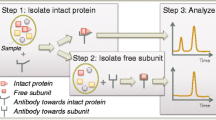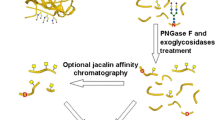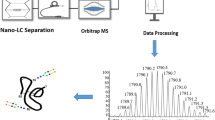Abstract
Human chorionic gonadotropin (hCG) is an important marker for pregnancy, pregnancy-related disorders, and various cancers. Different molecular forms of hCG occur in different clinical conditions, and these can be distinguished with immunoassays using well-characterized monoclonal antibodies. Exact knowledge of the epitopes of the antibodies used is crucial for the design of assays with desired specificity. The epitopes of many hCG antibodies have been determined by comparing their reactivity with six 1st International Reference Reagents (IRRs) for hCG, but the specificity of some antibodies remains to be exactly defined. We have therefore studied the reactivity of 30 monoclonal antibodies (mAbs) with the six 1st IRRs for hCG, and variants were investigated using immunoaffinity extraction combined with liquid chromatography–mass spectrometry (LC-MS/MS) for the detection of hCG variants by specific tryptic signature peptides. Each of the mAbs had previously been characterized with regard to epitope specificity in the 2nd Tissue Differentiation Workshop on hCG of the International Society of Oncology and BioMarkers (ISOBM). Simultaneous identification of different hCG variants by LC-MS/MS confirmed that two standards used for mAb characterization, nicked hCG (hCGn, 1st IRR 99/642) and nicked β subunit of hCG (hCGβn, 1st IRR 99/692), are heterogeneous, being composed of two major variants each: hCGn44/45 and hCGn47/48 as well as hCGβn44/45 and hCGβ47/48. Furthermore, MS revealed cross-contamination by non-nicked hCG of the 1st IRR hCGn (99/642) standard. This information enabled fine-tuning of the previous epitope classifications of mAbs specific for heterodimeric hCG (c-mAbs). LC-MS/MS confirmed that c2-mAbs and most c1-mAbs did not recognize hCGn as the observed response in radioimmunoassays obviously resulted from the contamination of hCGn with hCG. Thus, c1 and c2 epitopes are partially dependent on hCGβ peptide loop 2. c3-mAbs recognized both hCG and hCGn. It appeared that c-mAbs cannot discriminate between hCGn44/45 and hCGn47/48 as they either recognize both or neither variant. For most mAbs directed against hCGβ, epitope specificity determined by LC-MS/MS was highly concordant with that obtained using standard immunological methods. In analogy to c-mAbs, hCGβ-mAbs cannot discern between hCGβn44/45, hCGβn47/48, or intact hCGβ as all 15 mAbs recognizing hCGβ also recognized both nicked variants irrespective of which of the three major hCGβ antigenic domains their epitopes were located within: on the caps of peptide loops 1 and 3, around the cystine knot, or along the hCGβCTP. LC-MS/MS confirmed that their epitopes were not located on hCGβ peptide loop 2. Thus, LC-MS/MS provided in-depth information on hCG variant composition of hCGn (99/642) and hCGβn (99/692) and hCG variant specificity profiles and facilitated precise classification of the epitopes of anti-hCG mAbs. This has impact on the design of selective immunoassays.




Similar content being viewed by others
References
Stenman U-H, Tiitinen A, Alfthan H, Valmu L. The classification, functions and clinical use of different isoforms of HCG. Hum Reprod Updat. 2006;12(6):769–84. 2006 November 1.
Stenman U-H, Alfthan H, Hotakainen K. Human chorionic gonadotropin in cancer. Clin Biochem. 2004;37(7):549–61.
Lempiainen A, Stenman U-H, Blomqvist C, Hotakainen K. Free {beta}-subunit of human chorionic gonadotropin in serum is a diagnostically sensitive marker of seminomatous testicular cancer. Clin Chem. 2008;54(11):1840–3. 2008 November 1.
Marcillac I, Cottu P, Theodore C, Terrierlacombe MJ, Bellet D, Droz JP. Free hCG-beta subunit as tumor-marker in urothelial cancer. Lancet. 1993;341(8856):1354–5.
Marcillac I, Troalen F, Bidart JM, Ghillani P, Ribrag V, Escudier B, et al. Free human chorionic gonadotropin beta-subunit in gonadal and nongonadal neoplasms. Cancer Res. 1992;52(14):3901–7.
Saller B, Clara R, Spottl G, Siddle K, Mann K. Testicular cancer secretes intact human choriogonadotropin (hCG) and its free beta-subunit: evidence that hCG (+hCG-beta) assays are the most reliable in diagnosis and follow-up. Clin Chem. 1990;36(2):234–9. 1990 February 1.
Wald NJ, Rodeck C, Hackshaw AK, Rudnicka A. SURUSS in perspective. Semin Perinatol. 2005;29(4):225–35.
Berger P, Sturgeon C, Bidart JM, Paus E, Gerth R, Niang M, et al. The ISOBM TD-7 workshop on hCG and related molecules—towards user-oriented standardization of pregnancy and tumor diagnosis: assignment of epitopes to the three-dimensional structure of diagnostically and commercially relevant monoclonal antibodies directed against human chorionic gonadotropin and derivatives. Tumor Biol. 2002;23(1):1–38.
Berger P, Paus E, Hemken PM, Sturgeon C, Stewart WW, Skinner JP, et al. Candidate epitopes for measurement of hCG and related molecules: The 2nd ISOBM TD-7 Workshop. Tumor Biol. 2013. doi:10.1007/s13277-013-0994-6.
Lapthorn AJ, Harris DC, Littlejohn A, Lustbader JW, Canfield RE, Machin KJ, et al. Crystal structure of human chorionic gonadotropin. Nature. 1994;369(6480):455–61.
Pierce JG, Parsons TF. Glycoprotein hormones: structure and function. Annu Rev Biochem. 1981;50(1):465–95.
Cole LA. Human chorionic gonadotropin and associated molecules. Expert Rev Mol Diagn. 2009;9:51–73.
Beck A, Sanglier-Cianférani S, Van Dorsselaer A. Biosimilar, biobetter, and next generation antibody characterization by mass spectrometry. Anal Chem. 2012;84(11):4637–46. 2012/06/05.
Laha T, Strathmann F, Wang Z, de Boer I, Thummel K, Hoofnagle A. Characterizing antibody cross-reactivity for immunoaffinity purification of analytes prior to multiplexed liquid chromatography–tandem mass spectrometry. Clin Chem. 2012;58(12):1711–6.
Lund H, Løvsletten K, Paus E, Halvorsen TG, Reubsaet L. Immuno MS-based targeted proteomics: highly specific, sensitive and reproducible hCG determination for clinical diagnostics and doping analysis. Anal Chem. 2012;84(18):7926–32. 2012/09/18.
Lund H, Torsetnes SB, Paus E, Nustad K, Reubsaet L, Halvorsen TG. Exploring the complementary selectivity of immunocapture and MS detection for the differentiation between hCG isoforms in clinically relevant samples. J Proteome Res. 2009;8(11):5241–52. 2009/11/06.
Birken S, Berger P, Bidart J-M, Weber M, Bristow A, Norman R, et al. Preparation and characterization of new WHO reference reagents for human chorionic gonadotropin and metabolites. Clin Chem. 2003;49(1):144–54. January 1, 2003.
Bristow A, Berger P, Bidart J-M, Birken S, Norman R, Stenman U-H, et al. Establishment, value assignment, and characterization of new WHO reference reagents for six molecular forms of human chorionic gonadotropin. Clin Chem. 2005;51(1):177–82. January 1, 2005.
Paus E, Nustad K. Immunoradiometric assay for alpha gamma- and gamma gamma-enolase (neuron-specific enolase), with use of monoclonal antibodies and magnetizable polymer particles. Clin Chem. 1989;35(10):2034–8.
National Institute of Biological Standards and Controls. WHO Reference Reagent Human Chorionic Gonadotrophin, nicked form (purified) hCG-n. NIBSC code: 99/642. http://www.nibsc.org/documents/ifu/99-642.pdf (2013).
Conflicts of interest
None
Author information
Authors and Affiliations
Corresponding author
Rights and permissions
About this article
Cite this article
Lund, H., Paus, E., Berger, P. et al. Epitope analysis and detection of human chorionic gonadotropin (hCG) variants by monoclonal antibodies and mass spectrometry. Tumor Biol. 35, 1013–1022 (2014). https://doi.org/10.1007/s13277-013-1135-y
Received:
Accepted:
Published:
Issue Date:
DOI: https://doi.org/10.1007/s13277-013-1135-y




